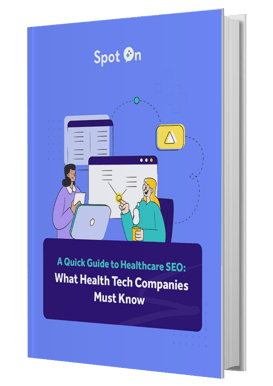Download the PDF to save this content for later:

Today's digital marketing strategies can't afford to overlook the importance of search engine optimization (SEO). If you say, "I'm putting keywords into my blog posts. We're good," you may encounter some unpleasant surprises when you look at your website analytics.
SEO has evolved rapidly into a discipline that encompasses multiple, interdependent aspects — from understanding the buyer's journey and staying current with algorithm updates to adopting a creative content creation approach and keeping up with the latest best practices.
Let's look at how you can get healthcare SEO marketing right, what you need to know about your audience, the nuances between technical and non-technical SEO, and how a healthcare technology marketing agency can help you attract high-quality leads to your website.


SEO is integral to a digital marketing strategy for healthcare tech companies. When done right, it can help you drive traffic, generate leads, and increase conversions. Here's an overview of how to maximize its impact.
 Healthcare SEO is a moving target — it's hard to keep up with all the changes, let alone get everything right. Let's look at how you can boost your ranking, increase visibility, and drive high-quality traffic to your website.
Healthcare SEO is a moving target — it's hard to keep up with all the changes, let alone get everything right. Let's look at how you can boost your ranking, increase visibility, and drive high-quality traffic to your website.
SEO is essential to an inbound marketing strategy by driving traffic to your website.
Whether you want to strengthen your overall inbound performance or refine your healthcare SEO strategy, these best practices will give you a leg up:
You must understand search intent to create engaging content to deliver the right messages to the right people at the right time. Your SEO strategy should cover these four types of search behaviors: Informational queries, navigational intent, commercial queries, and transactional investigation. You can also get inspiration from the "people also ask" section in Google search results.
Crafting content that resonates with prospects and customers is critical to driving high-quality traffic — we'll delve deeper into this topic in the next chapter.
The right keywords will help you drive the right traffic. Look for search teams that reflect your ideal customer's pain points and create content that addresses their challenges or answers their questions. Also, consider the search behaviors of every person in the buying team (e.g., CIO, clinicians, CFO).
Inform your SEO tactics with insights from keyword tools such as Google Search Console, Ahrefs, Moz, and SEMRush. Find the sweet spot by comparing each keyword's search volume and competitiveness. Also, incorporate long-tail keywords to reach prospects with high purchase intent.
On-page SEO involves more than using keywords in your content. To optimize your web pages, you must write meta descriptions that pique curiosity and drive clicks, create SEO-friendly URL slugs, format the content with header tags and bullets, include internal links, and use visual elements to drive engagement.
Help search engines index your content by applying schema markup to your site. Also, reduce page load time and adopt a mobile-first design to improve your website's user experience.
What's the secret to picking fresh, engaging, and relevant blog topics that signal relevance to search engine algorithms? Set a solid foundation with an overall content marketing strategy. Then, identify messaging gaps and consider each buying team member's priorities.
Create pillar pages by grouping content to support a link-building strategy to boost your SEO ranking. Also, choose topics you can easily update or repurpose (e.g., annual statistics or a top 10 list) to make your effort go further.
Keeping up with the latest changes is essential for maintaining your SEO ranking. For example, an analysis conducted by SEMRush found that Google search engine results pages (SERPs) show fewer informational results and more commercial and transactional ones — and your strategy must respond to the shift.
Meanwhile, zero-click searches have changed how you may achieve higher visibility — you must get ranked in zero-click results to achieve top SERP positions. As such, you need a well-rounded digital strategy and high-quality, relevant content to cover all the bases.
What gets measured gets done. But which KPIs should you track?
Measure your conversion rates, cost per acquisition (CPA), organic visibility, return on investment (ROI), keyword ranking, and organic click-through rate (CTR) to fine-tune your approach.
Set up Google Analytics to see which traffic source brings you the highest quality prospects. Gain insights from social media to see what content generates the most engagement and apply the formula to other intent or topics in search.
Now we've got the basics covered, let's see how you can implement an effective SEO strategy.


Your SEO strategy should help you attract high-value prospects into your sales pipeline — and it starts with identifying your audience. Let’s dive in:
Producing valuable, educational, and engaging content that resonates with your prospects and addresses their challenges is the foundation for any effective healthcare SEO strategy. Here's how to gain deep insights into your audience and build SEO campaigns around their needs:
|
Understanding Your Target AudienceUse information from different sources to gain a 360-degree understanding of your ideal audience. These include website analytics, social insights, competitive analysis, and long-tail queries. You can learn about their demographic data, what they care about, and how to target your content. |
|
Leverage SEO to Understand the Voice of the CustomerSEO is no longer a siloed channel — it offers dynamic opportunities to understand what your customers think and learn about macro trends that impact their behaviors. Use insights from your SEO research to understand purchase intent, improve the customer experience throughout the buying journey, and optimize your content for every customer lifecycle stage. |
|
Align Healthcare SEO Strategy with the Buyer's JourneyYour strategy must align with the complex and often non-linear B2B buyer's journey. Use journey mapping techniques to see how prospects use different search terms at various customer lifecycle stages. Then, produce relevant content to align your healthcare SEO strategy with your audience's goals and concerns. |
|
Create Content to Match Customer Lifecycle StagesHow do you get in front of high-quality prospects when they're researching online and attract them to your website? You must produce relevant content that matches where they are in the buying journey.
|
|
Capture Leads with High-Value, Gated ContentBesides getting prospects to read your content, you must collect their data and continue the conversation. Offer free, valuable, gated content like eBooks or white papers for visitors to download in exchange for their information. Craft your offer based on topics and keywords your prospects search for at each customer lifecycle stage. And don't stop at one — create multiple pieces of content to increase the number of touchpoints and progress prospects down the sales funnel. |
|
Attract High-Quality Leads with Product-Led ContentProduct-led content demonstrates how your solution solves the audience's challenges and is particularly suitable for the middle or bottom of the funnel, where readers are actively evaluating options and are ready to buy. Illustrate how your products can help the audience with tangible and relatable case studies. But don't just toot your own horn! The content should target keywords with high purchase intent, entice searchers to click through, and provide value to build trust. |
|
Personalize the Customer JourneyMarketing personalization connects your content to each prospect's interest, role, and customer lifecycle stages to deliver the right message at the right time. Use marketing analytics and automation tools to track prospects' interactions with your content and further personalize the experience to drive engagement. |
While addressing your audiences' needs is critical, we can't afford to overlook how search engines crawl and index your content. To ensure it appears at the top of relevant SERPs, you must understand the inner workings of technical and non-technical SEO.
To understand the nuances of this topic, we asked Brian Cauble, partner and head of SEM/SEO strategy at Spot On, to share his from-the-trenches insights.
Technical SEO involves understanding how search engine algorithms read your site, determine ranking signals, and index your content. Non-technical SEO focuses on your keywords, content, and site structure. "Simply put, technical SEO is for the robots (search engines), and non-technical SEO is for the human audience," says Cauble.
However, they share the same objectives: To ensure that search engine algorithms can understand your website content to rank it correctly — ideally at the top of SERPs.
![]()
You need both technical and non-technical SEO to help Google understand your content. You may write the best blog posts in the world, but if your site structure doesn’t help search engines understand your content, your ranking will suffer.
– Brian Cauble, Partner and Head of SEM/SEO Strategy at Spot On
On-page SEO concerns how you structure the content to help Google understand it. Meanwhile, off-page SEO involves everything else you do outside your website to affect your ranking. These include signals that Google uses to gauge your online reputation, such as backlinks, product reviews and ratings, and social engagement or sharing.
When you partner with a healthcare marketing firm, you can access different expertise to cover all the bases. An SEO strategist identifies topics and keywords, a content specialist creates blog posts and optimizes them for on-page SEO, and a different team focuses on technical SEO and off-page optimization.
Google's core updates can significantly impact your SEO rankings and traffic. For instance, the EEAT (experience, expertise, authoritativeness, and trustworthiness) update weighs reviews, testimonials, and backlinks from high-authority sites more heavily. When it rolled out, it changed how sites are ranked on SERPs.
"Sometimes Google provides guidance on the updates. But when it doesn't, we dig around and consult with our colleagues in the SEO industry to figure out what the changes are," says Cauble.
So, how can you tell your SEO strategy is effective and not impacted by Google updates? "We use lead indicators such as traffic and ranking. We also dive deeper into metrics like cumulative rankings, number of top 10 rankings, and best ranking for a term to gain insights," says Cauble.
"If you used to rank top 10 and got dropped to 25, you're probably targeting an important term, and we need to dig deeper. If I see a significant drop in traffic not caused by seasonal fluctuations, we'll investigate. It's important to monitor the little red flags before they become big issues."
Be aware of these potential issues that could prevent Google from properly indexing your site.
Here's how to fix them:
Add internal links to connect your content pieces so Google can better understand how they support each other.
Reposition the content by targeting keywords with higher search volume for it to get found by your target audience.
You won't rank high for competitive search terms if your website doesn't have enough authority. You may target long-tail keywords with lower search volume but high purchase intent.
Creating high-quality content for your ideal audience is the foundation for SEO success. Then, support your strategy with ongoing efforts and monitoring.
"We use SEMRush to pull monthly reports to see what's trending. We run reports and look at our clients' traffic and rankings every month to identify major shifts. Is the traffic going up and to the right on pages? If you're publishing great, keyword-optimized content, but your ranking isn't improving, you should look into your technical SEO," says Cauble.
We expect many businesses to produce numerous blog posts using generative AI. “It’s an important tool for marketers, and we are already experimenting with the best ways to use it for optimization,” Cauble says. But how do you stand out in a sea of AI-generated content?
It's more important than ever to differentiate your brand and strengthen your reputation with content that signals experience, expertise, authority, and trust (EEAT). Plus, don't overlook the importance of following the latest SEO best practices:
Design a site structure with sound technical SEO so that it facilitates Google “understanding” your content.
Create pillar pages to target the right keywords and build internal links.
Conduct keyword research to learn how your target audience searches for solutions.
Perform a search on Google to see what appears on the results page — is your content there?
Build backlinks to increase your website's authority over time.
Include quotes, reviews, and testimonials to enhance trust and credibility.
Use the right tools to research keywords and monitor your ranking.
Establish a regular cadence to publish high-value content.
"You don't have to spend a lot on healthcare digital marketing services, but it's important to understand the basics and manage all the moving pieces," says Cauble.
This advice takes us back to knowing your audience and addressing the entire customer lifecycle: What do you want visitors to do after reading your blogs? How will they learn more about your brand and products? How will you capture their information to nurture relationships?
Managing all the variables can be overwhelming. That's why more businesses turn to reputable healthcare tech agencies to help them manage their SEO strategy.

Partnering with an experienced healthcare tech agency helps you integrate the latest SEO tactics into your overall marketing strategy cost-effectively. Let's look at how these experts can help you cut through the clutter.
Thinking outside of the box is great, but there's a fine line between innovative content ideas and lasting SEO results. "There's a structure to SEO. You have to follow best practices, and within that, you get creative," says Cauble.
There are two main approaches to effective SEO:
Here’s how they work hand-in-hand to drive results.
Don’t get caught up in the mechanics of SEO at the expense of achieving your end goal — to build trust and relationships with your audience.
Here’s how to create appealing content that’s also good for SEO:
Google's "helpful content update" emphasizes a satisfactory website experience, rewarding people-focused content. "First, focus on addressing the audience's questions or concerns. Then, come back to the content and fine-tune it to cover your SEO bases," says Cauble.
Engage the audience and deliver value by adding visuals to complement your story. They can support your narrative and encourage social sharing.
 Healthcare Marketing Trends: Drive SEO with Creative Content Format and Distribution
Healthcare Marketing Trends: Drive SEO with Creative Content Format and DistributionA healthcare SEO agency can help you experiment with various approaches and engage your audience with different content formats and distribution methods.
Optimize images by adding descriptive file names, informative alt tags, and engaging captions. Also, incorporate videos because they appear as rich snippets on SERPs and include the transcript to cover more relevant keywords.
Combine images, infographics, videos, and written content to deliver a rich and engaging user experience.
![]()
Google doesn’t reward people trying to play the game and shortcut the system. It wants to support those producing high-quality and helpful content for its users.
– Brian Cauble, Partner and Head of SEM/SEO Strategy at Spot On
Include star ratings, reviews, pricing information, event details, etc., to help search engines process your content more accurately. Plus, your SERP listing will appear in more places to provide relevant information while capturing prospects’ attention.
Your healthcare SEO agency should help you localize your content. This tactic puts you in front of a targeted audience segment and increases click-throughs with highly relevant content.
“Tracking your competitors and doing keyword research is as much an art as a science,” says Cauble. “Some of our clients are startups offering unique solutions outside a traditional, defined category. We often have to get creative, see how others talk about the topics, and use descriptive keywords in our SEO strategy.”
“I use AI in my keyword research to help me think outside the box and find edge case keywords. But it can’t replace human expertise. It’s a tool, so you may have to try different queries to get meaningful results,” says Cauble. “But it can give you a very good jumping-off point.”
Earn backlinks and media placement from a recognized organization like a university or government agency website to increase your domain authority. But implementing this tactic is easier said than done. Let’s review an example of how an agency can help you earn these media placements.
We created a unique program for community outreach to help a client generate buzz and build backlinks from high-authority sites. The initiative gives credible organizations a reason to link to the client’s site. Meanwhile, the client wins goodwill by supporting the communities.
Content doesn’t have much to do with this creative approach. We tapped into the power of PR and focused on creating a mutually beneficial situation where high-authority sites are excited to promote our client’s brand. As a result, our client gained customer trust and established leadership positioning in the market.
Healthcare SEO is complex — you have to learn the basics, develop a deep understanding of your target audiences, stay on top of Google updates, know the best practices for technical and non-technical SEO, and think creatively to produce content that cuts through the clutter.
When you partner with an experienced healthcare tech marketing agency, you have access to a team of experts who will help you navigate the competitive and fast-changing SEO landscape. If your healthcare SEO strategy isn't delivering the expected results, it's time for a change. Spot On helps healthcare SaaS companies audit and develop their SEO strategy. We'll work with you to design a plan that resonates with your target audience and nurtures leads to convert.
Book a meeting to see how we can help you leverage SEO to support your healthcare marketing strategy.


A Quick Guide to Healthcare SEO: What Health Tech Companies Must Know